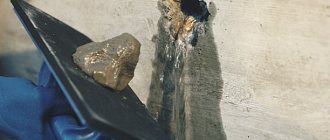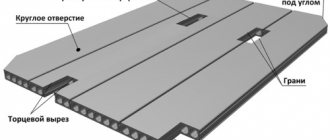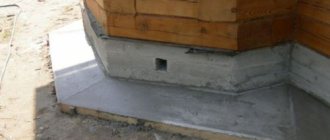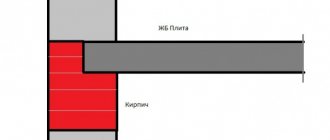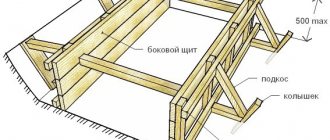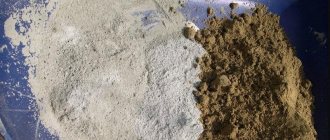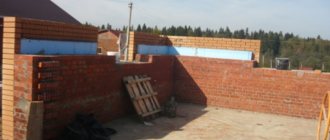A leak in a well can seriously affect the quality of drinking water. Through a seemingly small hole in the concrete shaft, household wastewater and technical fluids spilled on the ground will begin to penetrate. Sand will fall off from the horizons lying above the aquifer, which will negatively affect transparency. It's unpleasant, isn't it?
To restore the integrity of the well shaft, a quickly hardening composition will be required, which will allow you to quickly eliminate the defect in the concrete structure. A hydraulic seal for a well will eliminate leaks, large and small cracks forever. We will tell you how to choose it correctly.
We describe in detail the process of applying the repair composition. A valuable option from the author are recipes for making fillings yourself. The information is supplemented by useful diagrams, photos and video tutorials.
Causes of leaks
The technology for constructing wells with shafts from modular reinforced concrete structures involves installing rings on a sand-cement mortar. By filling all the uneven joints between the upper and lower rings, the construction mixture should create a reliable barrier against melt and ground water.
Contrary to popular belief, sealing with sand and cement mortar is also necessary for well modules with a locking connection. The presence of the latter prevents the rings from moving, but does not protect the joint from leakage.
When talking about leaks between well rings, people most often remember the deterioration in the quality of drinking water, completely forgetting about the danger of gradual destruction of the well shaft
It should be noted that such primitive waterproofing gives a positive result - the drinking spring shaft remains dry. However, the absence of leaks in the first years of operation is not a guarantee that this idyll will continue forever.
As a rule, even on stable soils, after 4-5 years the surface of the concrete shaft becomes covered with wet spots, which soon turn into dirty streaks and streams. You should not blame yourself or the builders for the fact that the work was done incorrectly. Most often, leakage occurs for completely different reasons:
- Simple mortar is not intended for use in such harsh conditions. Constant humidity, temperature changes and exposure to salts dissolved in water contribute to its cracking and destruction.
- If a well is dug in an area with pronounced seasonal soil movements, then its trunk is subject to regular mechanical stress. As a result, you can observe not only cracks at the joints, but also the mutual displacement of the concrete rings in the horizontal plane.
- In the northern regions, the upper rings are exposed to the forces of frost heaving. Because of this, they can not only move horizontally, but also move up and down.
- Force majeure, expressed in the displacement or subsidence of the rings due to the appearance of quicksand.
- Poor-quality materials - in rings made in violation of technology, various defects may appear over time - through cracks, crumbled areas, etc.
You should take care of waterproofing a well at the stage of its construction - in the future this will save a lot of time and effort
If a well is constructed with the simultaneous laying of rings, then very often even simple sealing with mortar is not performed. In both this and other cases, it will be necessary to carry out a set of measures to ensure reliable waterproofing of joints.
Septic tanks
Most often, septic tanks (overflow wells) have such a concrete structure. They consist of 2-3 tanks connected to each other by overflow pipes. Septic tanks are designed to collect sewage from a private home. Insoluble impurities of such wastewater settle at the bottom of the first reservoirs. The water, cleared of impurities, is poured by gravity through a pipe with an inclination into the next tank. In this case, the solid and liquid phases of the wastewater are separated. The last, filtering, tank has no bottom.
Displacement of the well rings can cause destruction of the insulation between them. The upper ring is subject to the most damage due to soil freezing. Therefore, when installing each one, it is necessary to provide for its fastening with neighboring ones: brackets, rings with locks, etc.
If displacement cannot be completely prevented, it is worth paying attention to those types of insulation that are not afraid of such movement.
Methods for sealing joints in a well made of prefabricated concrete modules
To seal joints between concrete rings, you can use one of the following methods:
- plastering;
- sealing with roll waterproofing;
- applying bitumen mastic;
- filling cracks with sealants;
- use of polymer inserts.
The choice of a specific sealing method depends on what kind of well you are dealing with - one under construction or in operation. In addition, you will have to take into account construction technology, soil characteristics, depth of the drinking water source and other factors.
It should be noted that the best results are obtained by a combination of several waterproofing methods - only in this case can you count on one hundred percent success.
Plastering
The use of special plaster mixtures is perhaps the most common method of waterproofing. The popularity of sealing joints using plaster is explained both by its simplicity and accessibility, and by the ability to carry out work from inside and outside the well. Sealing is carried out using spatulas, with which the mortar is pressed into the cracks and cracks. The plaster is applied until the solution completely fills the gap, after which the liquid mixture is leveled over the joint surface.
Sealing joints with plaster is one of the simplest and most affordable methods of sealing, which makes this method very popular among home craftsmen
There is little point in using ordinary sand-cement mortar - there is a very high probability that over time it will crack and the seam will leak. It is best not to save money and use special compounds called hydroseals.
You can get additional information about the use of hydroseals for sealing joints of well rings here: https://aqua-rmnt.com/vodosnab/kolod-skvaj/gidroplomba-dlya-kolodca.html
Manufacturers produce hydraulic seals “for all occasions” - if necessary, you can even find a composition that can instantly stop a leak with a pressure of up to 7 atmospheres
Made on the basis of aluminum cement, fine sand and chemically active additives, hydroresistant mixtures have a reduced setting time and, in addition, have such necessary properties as frost resistance, strength and plasticity. With their help, you can not only seal the dry joint between the rings, but also eliminate leaks under pressure.
Preventing the question of specific brands of hydroseals, for general cases, materials such as Penetron and Penecrete can be recommended. If you urgently need to fix a pressure leak, then choose Waterplug, Puder-Ex or Peneplug - they have a minimum hardening time and high adhesive ability in a humid environment.
Hydroseal is a high-tech, quick-hardening composition, therefore, when preparing it, you should strictly follow the manufacturer’s recommendations
Application of roll waterproofing
As a rule, the area of the well shaft at a depth of up to 3 meters from the surface is most exposed to groundwater. In this case, the joints can be protected using roofing felt or other rolled waterproofing. To do this, a ditch about a meter wide is dug around the well and a layer of waterproofing is fused or glued onto the upper rings.
External waterproofing must be welded or installed on a layer of glue - simply wrapping it with plastic film is not enough here
To further protect the well from rain or melt water, the pit can be filled with clay. After thorough compaction, it will act as a hydraulic lock, preventing moisture from penetrating the well shaft.
In addition to rolled materials, you can find special sealing strips on sale. Unlike roofing felt, they can be used to localize cracks from the inside.
Self-adhesive sealing strips have high adhesion to concrete surfaces and can be used to waterproof joints both outside and inside wells
Using bitumen mastic
To waterproof with liquid bitumen, the rings are dug out to the required height and thoroughly cleaned of dirt. After this, resin (tar) dissolved in gasoline is applied with a wide brush. Since a thin film of bitumen will not be enough for high-quality waterproofing, at least three layers will be needed. For better adhesion to the concrete surface, the first penetration is made with a mixture in the proportion of 1 hour of resin to 4 hours of gasoline, and the other two - in a one-to-one ratio of components.
To seal the well from the outside, you can use either ready-made rubber-bitumen mastic or home-made tar
It should be noted that roll waterproofing, like tar itself, cannot be classified as environmentally friendly materials. For this reason, the surface of the joints on both sides is pre-protected with a layer of moisture-resistant plaster - it will serve as an additional guarantee that substances hazardous to health will not get into the well.
Before you start coating the outer part with a bituminous composition, the seams should be plastered
Sealing inserts
There are situations when reinforced concrete rings are so worn out that their repair, as well as sealing the joints, does not bring the desired results. In this case, you can use the most effective method - install plastic liners inside the barrel.
Using a plastic liner you can repair the most hopeless well
Such inserts are made from high-strength polymers and, depending on the diameter, have a wall thickness of 5 to 8 mm. On their outer surface there is ribbing, thanks to which the cylindrical liners resemble a huge corrugated pipe.
The outer helical rings of the polymer play a very important role. They allow you to increase the rigidity of the structure and make it possible to connect plastic modules with virtually no gaps - in this way you can get a cylindrical pipe of any height.
Sealing a well with a polymer insert is a complex and expensive undertaking, so it is best to entrust this work to professionals
The industry has mastered the production of sealing inserts for concrete rings of any diameter, so choosing a plastic cylinder for a well is not difficult. In-ears could be called an ideal option, if not for one thing - this option is the most expensive of all those considered.
The dimensions of the polymer liners correspond to the internal dimensions of standard reinforced concrete rings
Solid elastic coating materials
This solution can be used for waterproofing wells, swimming pools and foundations. Application is carried out on prepared substrates, and then the material is left until dry. After this, the waterproofing acquires:
- elasticity;
- high tensile strength;
- resistance to low temperatures.
The most popular solution on the domestic market is the Spanish product Tekmadray Elast, which is a two-component coating. DuPont products have also proven themselves well, as has the Italian Mapei. If you want to save money, you should purchase Russian waterproofing “Rastro”, which will be cheaper than its foreign counterparts. Waterproofing the well seams can be done using a tape sealant such as Rubber Elast.
Is there a folk alternative to expensive modern materials?
If immediate measures are required to eliminate the leak, and the above methods seem too time-consuming or expensive, then the gaps between the rings can simply be caulked. Both special rubber or fiber-rubber strips and flax fiber impregnated with fiber rubber, hemp or jute rope are suitable for sealing. Such materials are not in short supply - they can easily be found in retail outlets that sell products for waterproofing swimming pools. Sealing with sealing inserts allows you to eliminate gaps up to a centimeter wide and is nothing more than a temporary measure. Be prepared for the fact that over time the joints will need to be sealed with more durable materials.
With the help of available sealing materials, you can not only quickly eliminate a leak, but also save expensive sealing compound when sealing wide seams
Of course, it will not be possible to create a full-fledged replacement for hydraulic seals at home. However, craftsmen found a way out of the situation by adding liquid glass to the mortar. Since such a composition hardens in less than a minute, sand and cement are first mixed in a 1:1 ratio. One part of the alkaline solution is added immediately before applying the sealing compound to the joint or crack.
Video: sealing a well with a homemade hydraulic seal
How to seal
Hydroseal
The best option for sealing cracks is a hydraulic seal - a special material for a well. You can buy the dry mixture in special stores, after which you need to make the solution yourself.
In order for the composition to be of high quality, when executing it, strictly follow the recommendations from the manufacturer, which, in most cases, are printed on the packaging. The amount of dry mixture is selected in accordance with how active the flow is. In most cases, about 150 grams of water are taken per kilogram of hydroseal.
If the pressure of the leak is enormous, then you need to change the proportion, increasing the amount of dry mixture to seven parts. At the end of the kneading, which should last no more than 30 seconds, a solution resembling dry earth is obtained.
Note! The temperature of the water used for the solution must be 20 degrees Celsius.
It is forbidden to mix a lot of composition, since the hydraulic seal sets quickly. Based on this, the putty must be prepared in parts and only after its complete use has been completed can the next batch be prepared.
A solution of cement and liquid glass
Another popular option for sealing cracks is a solution of cement, liquid glass and sand. The proportion is 1:1:1.
This method has proven to be very effective and at the same time quite simple. True, after each cleaning of the well, you will need to treat the seams of the well with this composition again.
Features of sealing wells from the inside
Waterproofing a well column from the inside can be done either using cement compounds and materials, or using plastic inserts. In the latter case, it is better to entrust the work to specialists, but sealing the seams with plaster can be done on your own.
The first thing you should take care of is the construction of a comfortable and safe workplace. Do not think that using a rope ladder in your work is a practical and convenient option - you will change your opinion within the fifth minute of using it. Most often, a small shield suspended on strong ropes or steel cables is used for these purposes. Such a “cradle” is attached to a wooden beam or channel placed on the head of the well, and a powerful winch is used to lower it. As you have already understood, it will not be possible to do without assistants. In addition, you should take care of reliable insurance - you can use a strong rope tightly tied around your belt and attached to the support crossbar.
Waterproofing the upper rings can be done using a regular ladder attached to the well head
When repairing an operating well, water should be pumped out of it. This will clear the bottom of sludge and, if necessary, restore the filter layer. In addition, long-term layers of dirt and mold must be removed from the inner surface of the trunk. There is no better tool for this purpose than a high pressure washer. After completely cleaning the concrete surface, you will be able to see the damage in detail and decide on ways to eliminate it.
You can quickly and easily clean the inside surface of concrete rings using a high-pressure washer.
Sealing joints and cracks
To clean problem areas and seams between the rings, use a wire brush. Among other things, it will help to obtain a rough base to improve adhesion with the sealing compound. After this, the concrete is moistened with water and the plaster is applied. There are no difficulties here - the working mixture is forcefully pressed into the joints and rubbed over the surface.
It doesn’t matter how the cracks are filled - with a spatula or by hand. The main thing is that the sealing compound penetrates into the gap as deeply as possible
Only small cracks can cause difficulty - it is impossible to push the solution into narrow, thread-like cracks, and spreading the hydraulic seal over the surface will not give much results. In this case, the crack is widened using a hammer and a small chisel, trying to obtain a crack with a dovetail shape in cross-section.
When sealing wide cracks and through holes, a lot of working solution is required, so in order to save expensive purchased compounds, you can cheat a little. To do this, the main part of the filling is made from a thick sand-cement mortar or fiber-rubber cement, filling only the outer part of the “patch” to a depth of 1-2 cm with factory waterproofing.
The lower and upper rings of the well shaft are most susceptible to shear
What to do if the rings are displaced
If the shift of the concrete modules of the well shaft does not exceed 1/3 of the thickness of the rings, then waterproofing is carried out according to the above method. If there is a significant displacement, the trunk is dug up to the level of the damaged area and disassembled into its component parts.
When returning the removed links back, they must be laid on a layer of cement mortar and at the same time aligned with the lower ring. After this, the seams from the inside and outside are sealed with a special compound. We will return to the question of how to prevent possible displacement of the rings in the future.
External well waterproofing technology
When constructing a well, external waterproofing measures are usually taken. If we are talking about the need to protect the old structure, then a fairly large amount of excavation work will have to be carried out. For this purpose, roll materials, for example, roofing felt, are usually used. However, penetrating protection can also be used.
The surface should be prepared. The outer walls of the structure open as much as possible. To do this, dig the ground around the well to a depth of 4 m. The base is cleaned of dirt. If you have to work with an old structure, then you may see some parts of the reinforcement that have become exposed during operation. They should be cleaned and treated with an anti-corrosion compound.
If the waterproofing of a well is being repaired, the walls must be covered with soil; you can use “Betonkontakt” or a bitumen-rubber composition, which have proven themselves well, as well as cement-sand mortar, to which PVA glue is added. The composition is left to dry, and then bitumen or tar mastic is applied to it. Roofing felt is glued onto its surface, the seams between the sheets should be coated with mastic. When choosing penetrating insulation, you should skip the step of priming the walls. They are moistened and coated with Penetron, leaving them to dry for three days. The surface should be moistened periodically.
Step-by-step instructions for sealing joints and sealing a well shaft
Before you begin sealing the well, you should prepare the following tools:
- containers for mixing working solutions;
- metal brush;
- surface scrapers or high pressure washer;
- spatulas;
- hammer drill or impact drill;
- wide paint brush with stiff bristles;
- hammer;
- thin chisel.
To repair a well you will need the simplest tools that any owner has.
The work should be done sequentially - this way you will not miss a single detail. In each specific case, individual decisions must be made, so there is no general algorithm. However, we present to your attention the most complete instructions for sealing well seams. We tried to consider the most important points in it so that you have a complete understanding of the nature and procedure for carrying out repair activities.
- Preparatory stage. All functional and decorative elements are removed from the existing well, completely exposing the head. If necessary, the well trunk is dug up to the third or fourth ring, and the water is pumped out using an electric pump. After this, the lifting equipment and working platform are installed.
- With the help of friends or relatives, they lower themselves into the well. Using brushes, scrapers and a high-pressure washer, clean the surface of the barrel. This is best done from top to bottom. At the same time, each ring is carefully inspected, assessing the scope of the upcoming work and the possible costs of material (do not forget that the “lifetime” of factory hydraulic seals is measured in minutes).
- Having sunk to the bottom, do not rush to clear it of silt. Firstly, during repair work, the bottom part will one way or another become contaminated with debris and falling solution, and secondly, this will provide an additional influx of water.
- Having cleaned the surface, they begin to seal the joint, which is located above the water surface. There is no point in sealing the rings that are installed below - this part of the well is located in the aquifer. The sealing is carried out in sections of 10-20 cm, and vertical cracks should be plastered from bottom to top.
Sealing dry cracks, as well as those from which water flows in small portions, does not cause difficulties. Difficulties arise with damage from which the jet comes out under pressure - the sealing compound is immediately washed out. In this case, at a distance of 25 cm below the leak, 1-2 drillings with a diameter of 20-25 mm are performed - they will serve to redirect the flow. After the main crack has been sealed, the holes are plugged with wooden pegs or rubberized tow and sealed with a thick layer of sealing solution.
- To protect the inner surface of the rings from fungi and mold, the concrete surface is completely coated with an antiseptic. Offhand, you can name some pretty good products: Nortex, Capatox or Ceresit CT-99.
- After the last crack is sealed, they go down to the bottom and clean the bottom filter. If necessary, the filter layer is restored. More information about how to clean a well can be found in this article: https://aqua-rmnt.com/vodosnab/kolod-skvaj/chistka-kolodca-svoimi-rukami.html
- Having gone upstairs, they begin to seal the outer surface of the well shaft. To do this, the walls are covered with two or three layers of bitumen mastic (tar) or roll waterproofing is glued (fused) onto them.
- The dug trench is filled with soil and compacted, creating a hydraulic lock made of rich clay at the very surface. The thickness of its layer should reach the point of maximum freezing - this will be the key to a dry well shaft during spring floods.
- Return to place and, if necessary, repair the outer part of the well and finishing.
The operation of the well does not begin immediately. You must wait until it is filled to the normal level and completely pump out all the water. Only after this can the source be considered suitable for use.
Clay fill must be arranged according to the rules, otherwise such a hydraulic lock will be of no use
Internal waterproofing of a well
Internal insulation is carried out after the construction of the well and the installation of the bottom. If you need to seal an old well from the inside, then the water must be pumped out and the concrete walls must be thoroughly dried, since most insulation materials must be applied to dry surfaces.
The work can be performed using the following waterproofing compounds:
- — special cement putty;
- — molten bitumen or bitumen-gasoline composition;
- — cement-polymer mixture;
- — bitumen-polymer composition;
- - polymer waterproofing.
The first two methods are the cheapest, but they can only be used for concrete sewer wells. Compositions containing bitumen should never come into contact with drinking water.
If, during the preparation of walls for insulation from the inside, leaks of external water are observed, use the so-called hydraulic plug - an instant-hardening cement composition AQUAFIX or "Peneplug". This will allow you to perform all the necessary operations to waterproof the well efficiently.
AQUAFIX is a quick-setting hydraulic solution for instantly stopping water leaks, which has a flow rate of about 1.6 kg/l.
Figure No. 9. AQUAFIX hydraulic plug
“Peneplag” is a dry construction mixture that consists of special cement, quartz sand of a certain granulometry and patented active chemical additives. "Peneplug" is used to instantly eliminate pressure leaks in structures made of concrete, brick, natural stone and has a consumption of about 1.9 kg/l.
Technology of work execution
Preparatory work is generally similar to work for external waterproofing of a well: the well must be drained and kept dry throughout the entire period of repair work, the surface must be cleaned and prepared.
Joints, crevices and cracks must be carefully gouged to a shallow depth of 20-25 mm and thoroughly cleaned with a hard-bristled metal brush.
Figure No. 10. Coating waterproofing AQUAMAT-ELASTIC
All potholes must be repaired using a cement-polymer mixture and wait until the solution has completely dried, and then proceed to the final stage of work. Finally, it is necessary to cover the surface of the well with coating waterproofing in two layers. Follow the recommendations in the instructions for the material. Our experts recommend using the special composition AQUAMAT-ELASTIC from ISOMAT.
Review of materials
Cement mixture
– there are ready-made dry mixtures on sale, which only need to be diluted with water according to the instructions and applied in several passes to form a layer of about 0.7 cm. The composition must dry for several days, so the surface must be moistened several times a day, and the well itself must be closed lid. The service life of such insulation does not exceed 15 years. For example, such mixtures are produced by the manufacturing company LITOKOL.
Bitumen-gasoline painting
– the composition is prepared with their components in equal quantities. It must be applied in three layers with a break of 12 hours. Follow safety regulations. This option, like bitumen-polymer mixtures, is acceptable for use only in sewer wells. The service life is short - 5-10 years. Fused roll insulation can serve up to 30 years.
Cement-polymer mixtures
- This is the most affordable of modern effective waterproofing materials. The best system today is the ISOMAT system. It includes the already mentioned AQUAFIX hydraulic plug, a modified repair composition MEGACRET-40 for sealing cracks and puttying joints and a finishing two-component elastic mixture of cement and polymer materials, which must be applied by coating in a layer of up to 0.3 cm. This composition is completely inert, environmentally friendly safe, does not affect water quality in any way.
Figure No. 11. Repair composition MEGACRET-40 for sealing cracks and puttying joints
The same high-quality result can be obtained using inexpensive non-shrink coating Penecrit or Penetron Admix. It is applied in 3 layers with a spatula. The service life of cement-polymer waterproofing is about 40-50 years.
A more expensive option is the two-component composition CeresitCR 166, which has increased elasticity. It should be applied in two layers, with a reinforcing fiberglass mesh placed on the first layer before it hardens. The service life of this waterproofing exceeds 60 years.
Polymer waterproofing mixtures
- This is the most expensive, but also the most effective method, since the polymer membranes that are installed on special mastics are very elastic. If your well is unstable, deformations and new cracks may appear, then you should not save money, but purchase polymer waterproofing. The most attractive price/quality ratio is for domestic products of the TechnoNIKOL brand. In this case, you will not be bothered by leaks in the well for at least 40 years.
How to prevent well rings from moving in the future
You will have to come to terms with the displacement of the lower rings - digging out a trunk to such a depth is an extremely time-consuming and expensive task. Since most often the shift occurs due to weak soil or quicksand, there is no guarantee that after repair the problem will not recur. As for the upper 2-3 rings, they should be returned to their place without fail - this will allow for high-quality waterproofing and thereby avoid flooding of the mine with perched water.
The use of well rings with rebated locks prevents their horizontal displacement
The simplest thing that can be done to prevent horizontal movement of well rings is to replace them with hollow reinforced concrete modules with interlocking connections. For those who are embarrassed by the additional costs, we can recommend connecting adjacent rings using durable metal brackets or thick steel plates. To do this, holes are drilled at a distance of at least 25 cm from the joint, into which the bracket is driven from the outside. The edges sticking out inside are folded and carefully sealed. If plates are used, they are installed on both sides and secured with bolts with a diameter of at least 12-14 mm.
Concrete rings can be connected together with metal clamps and straight or curved plates made of thick steel strip
The method of connecting rings using metal fasteners is widely used by experienced craftsmen when digging wells. Concrete modules fastened together settle down much better, since the lower links pull the upper ones along with them. In addition, the likelihood that the rings located in the water horizon will “float away” under the influence of quicksand is reduced.
On heaving soils, cracks in the joints appear due to the fact that the soil tries to push the upper rings upward, lifting them above other parts of the well shaft. In this case, the trunk is dismantled to a depth below the calculated freezing point and the cylindrical modules are replaced with conical ones.
Factory or hand-cast cone rings will remain in place even on the most heaving soil
Prefabricated cone rings are almost impossible to find, so you will have to cast them yourself. The slope of the latter should be directed inside the structure and range from 10 to 15 degrees. Due to this, the buoyant forces reverse their direction, pressing the upper concrete module against the well shaft.
Waterproofing process after installation of rings
The next equally important issue is the implementation of insulation work. To avoid possible problems in the future, before starting insulation work, you need to decide on the best option for sealing the joints of the rings in the well. Of course, all joints must be processed during the construction process, so that later you do not have to return to this issue. It is necessary to use high-quality bitumen-based materials that provide the required level of waterproofing. It is necessary to choose correctly not only what will be used to cover the connecting seams, but also the staples and reinforcement, which should form a monolithic structure. First, the rings are seated and the seams are filled with sealant, after which the rings can be joined. Next, holes are drilled at the connecting joints, into which steel brackets are installed, also necessary for the connection. Standard ring elements can also be used, to which steel ties are attached for fastening purposes. In order to avoid corrosion, screeds are treated with special waterproofing compounds or covered with sealants. As a rule, sealants that have a polymer base are used, and painting occurs in several layers. This creates a very strong connection structure that even quicksand cannot destroy. Provided that the sealing stage was skipped during the construction phase, after some time the well will have to be repaired. Many people leave seams between wells without caulking them, believing that this will help fill the well. However, only those who are very poorly versed in the issue of building a well can do this.
Video: how to seal seams in a well with a prefabricated reinforced concrete shaft
Now you know what you can use to seal cracks between concrete rings and how to prevent their occurrence. We will be glad if our advice and recommendations help make the drinking water in your well tastier, cleaner and safer for health. Leave feedback on the article, share your own ways to solve the problem and ask questions. Our experts will provide you with qualified assistance in the shortest possible time.
- Author: Victor Kaploukhiy
Thanks to my varied hobbies, I write on various topics, but my favorites are engineering, technology and construction. Perhaps because I know many nuances in these areas, not only theoretically, as a result of studying at a technical university and graduate school, but also from the practical side, since I try to do everything with my own hands. Rate this article:
(10 votes, average: 4.9 out of 5)
Why do you need to protect wells from water?
Figure 1. Waterproofing a well made of concrete rings. An
underground concrete structure is affected by many negative factors, so without specific protection it can quickly become unusable. The need for waterproofing wells is dictated by the following reasons:
- If concrete absorbs moisture, then at negative temperatures it begins to expand. In this case, the ring becomes covered with cracks and eventually completely collapses.
- Contaminated perched water may enter the well excavation. At the same time, drinking water becomes cloudy, and the source itself dies.
- If the joints between the concrete rings are not sealed, groundwater will flow into the sewer well, overflowing it. In this case, the nearby soil becomes contaminated with runoff and becomes unusable.
- Washing out compounds for insulating joints. Even the smallest trickle becomes larger over time. If repair measures are not taken, the structure will collapse.
Water from the well can flow beyond its boundaries, which leads to subsidence of the soil. In this case, the structure warps and falls apart. To avoid such negative consequences, timely waterproofing of concrete rings and their joints must be carried out.
Fixing rainwater leaks in the upper seams
If the source is contaminated by overhead water, there will be little help in eliminating gaps using cement mortar. The seam will quickly be washed away by rain streams and it will not even have time to set properly. What can help in such a situation?
These are special building mixtures: HydroStop, Waterplug, Peneplug and others. The main properties of these compositions are rapid hardening and penetration into all small cracks, which makes it possible to reliably eliminate leaks.
Their advantages over other solutions:
- resistant to temperature changes
- absolutely waterproof
- do not react with salts and other aggressive substances
But the mixtures are not very accessible, because they have a high price.
There are two ways to strengthen the water resistance of seals of joints and cracks in a well by applying a hydraulic seal. Use a composition that is mixed according to the manufacturer's instructions.
Dry powder is diluted with warm water at a ratio of 5:1. This ratio may vary depending on the size of the gap. The mixture is prepared in small portions, as it hardens quickly.
In this case, the ingredients are quickly mixed and applied to a previously prepared area with your hands. You need to manually press firmly on the composition and then hold it in this position for 2-3 minutes.
If the mass of groundwater behind the walls outside the well enters under increased pressure, and the holes between the concrete parts are significant, the second method can be used. Using a hammer drill, 25 cm below the joint level, punch 2 holes so that water rushes into them.
In this case, the flows in the gap between the parts should weaken or disappear, which will facilitate the work of applying a layer of waterproofing composition. When it hardens, pegs are driven into the holes and also coated.
Ready-made hydraulic seal for wells: how to use it
With the help of quick-hardening solutions it is possible to effectively combat:
- with water leaks from reinforced concrete tanks;
- with water breakthroughs in basements, tunnels, mines, adits, galleries;
- with defects that have arisen in the bowl of swimming pools and other artificial reservoirs;
- with capillary leaks appearing in the area where the floor and walls meet, between foundation blocks, etc.
A solution for sealing leaks can be prepared from a dry mixture, strictly following the instructions. As a rule, per kg of dry mixture you need 150 ml of water at 18-20 degrees. If necessary, you can mix small volumes of waterproofing composition based on the proportion of 1 part water - 5 parts dry cement.
The solution is mixed for half a minute, after which it is immediately applied to the area with the leak.
Which mixtures for waterproofing are better:
- Waterplug. Diluted with slightly warm water. Hardens within 120 seconds, used at temperatures from 5 to 35 degrees.
- Peneplug. In addition to concrete, it can be used to eliminate leaks in brick and stone wells. Hardening time – 40 seconds.
- Puder ex. One of the fastest-acting fillings, hardens in 10 seconds. Not used at temperatures below 5 degrees.
During the preparation of the solution, as well as subsequent work with it, certain rules should be followed. Always wear a respirator and protective gloves when working. To mix the solution, do not use any liquids - only ordinary water, and the container must be metal.
Precautions during operation
Experienced specialists suggest several options for work and explain how to seal the seams in the well between the rings. There are several methods of sealing.
To prevent the joints of the well walls from allowing soil to penetrate inside, the parts are “stitched” into a monolith using any of the following options:
- plastering
- sheathed with rolled types of moisture-proof materials
- sealed with special inserts
- putty using special compounds
Depending on the type of work, various materials are used, which will be discussed below.
To carry out the sealing process, you also need to prepare all the necessary tools. If you need to carry out waterproofing work on your own, then you should take care of safety precautions and available materials.
To perform this type of work you need to prepare the following:
- safety rope
- helmet
- powerful flashlight
- special wading boots
- latex gloves
The sealing of the annular joints of the walls must be carried out together with 2-3 workers, so that they help the main performer during the sealing process, hold the cable at the proper level and pull the person out of the well.
The technology for using a hydraulic seal for a well is not particularly complicated, and therefore can be performed by a novice master without the involvement of specialists. When working with the solution, protect your hands with gloves. After use, the tool must be immediately washed from any remaining mixture, otherwise, after final hardening, it will be difficult to clean it only mechanically.



